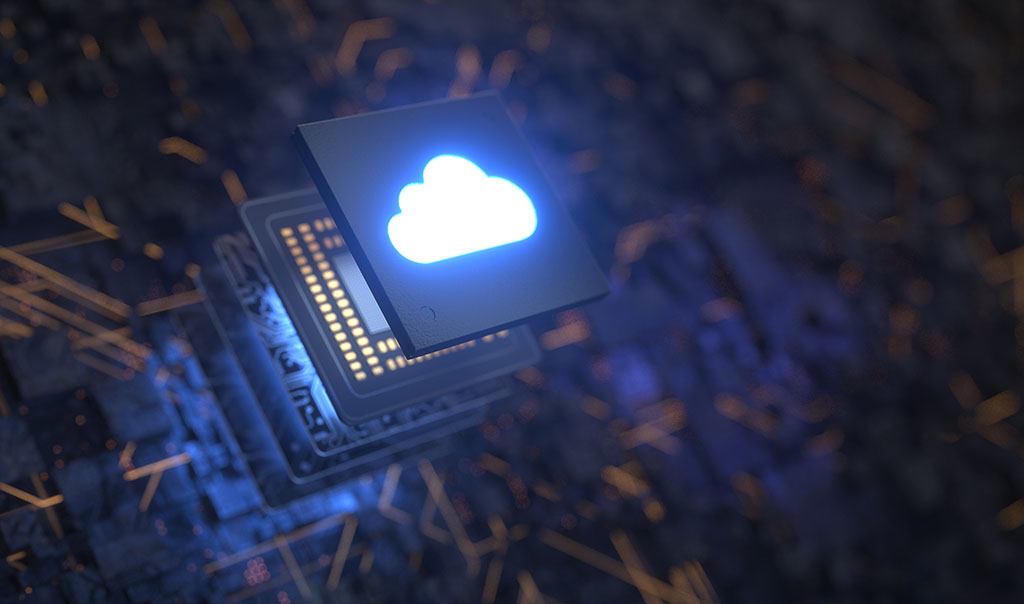5 Ways Connectria’s IBM + AWS Hybrid Cloud Can Work for You
Connectria
Author
Date
February 23, 2021
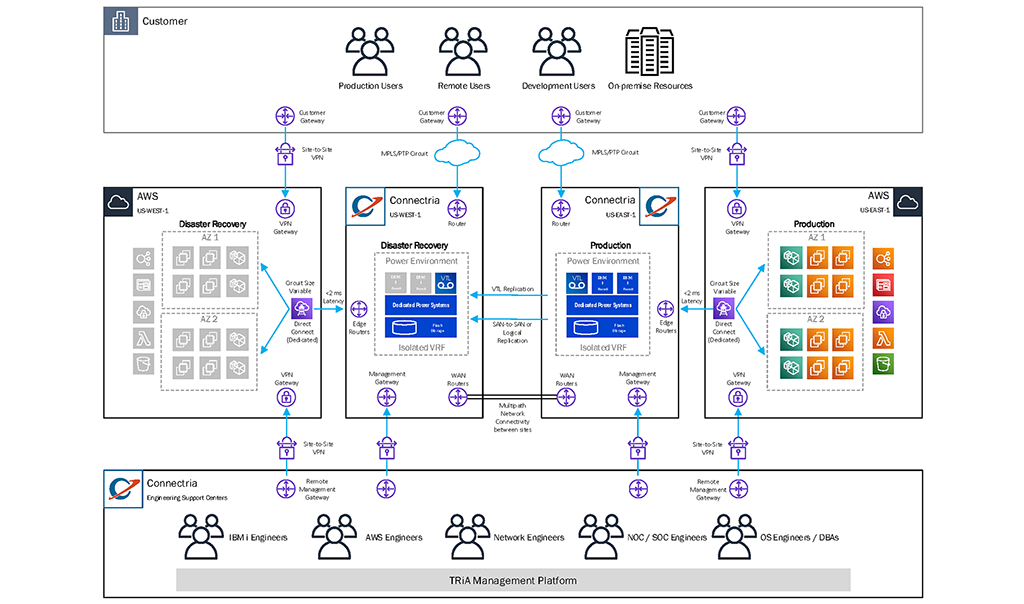
Connectria’s IBM + AWS Hybrid Cloud brings the unique capabilities of IBM Power Systems servers to its data centers in close proximity to AWS. This allows for low latency direct connections between IBM i/AIX systems and AWS. This opens up new possibilities for IBM workloads to leverage advanced data analytics, multi-region high-availability (HA) deployments, and other forms of augmentation with AWS cloud services.
While I can talk about the individual pieces all day long, what you want to know is how this would work for your environment. While each environment is a little bit different, there are some commonalities. Below are some example architectures to provide an idea of how each would look in this hybrid model.
Download the Solution Brief for more information.
1. DRaaS

Starting with disaster recovery as a service (DRaaS), this example is normally the least cost entry for most and a way to get more familiar with AWS and Connectria services without a full implementation. For a lot of folks, this is an “easy button” for better protecting your environment while also taking steps into AWS or your public cloud du jour.
You can maintain your existing production on-site and replicate production systems to Connectria in AWS environments. While most folks use VPN tunnels for this, that isn’t the only method. Typically, logical replication using tools like MIMIX, iCluster, Maxava, or other similar tools can be used to replicate the environment into the DR facility. Some detailed replications could also be supported, you’ll just need to check with your Connectria sales rep for available options.
2. Site to Site Tunnels and Cloud LPARs
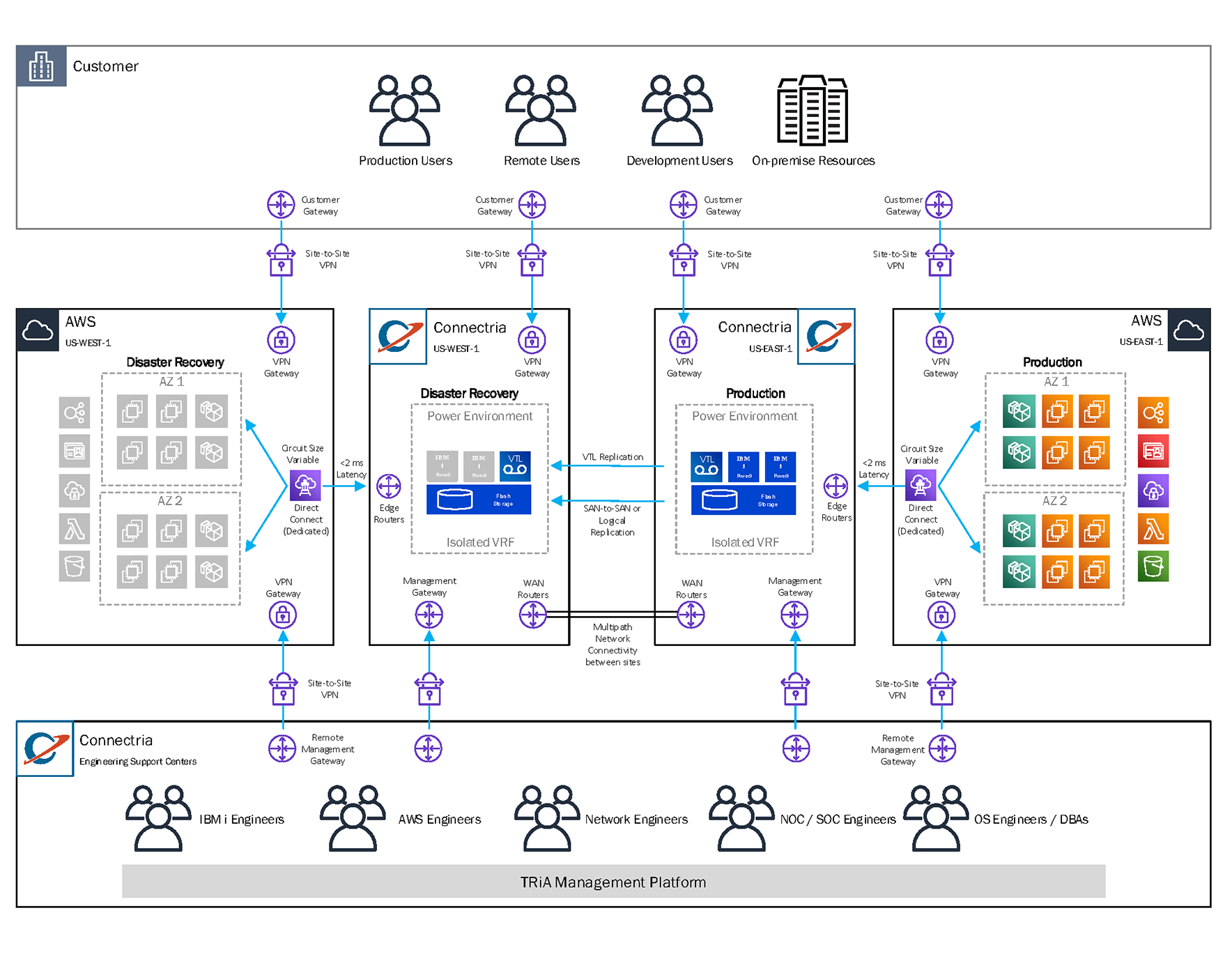
This example shows a production/DR environment using site-to-site VPN tunnels and using Connectria’s cloud Power Systems boxes. This particular case illustrates a multi-availability zone environment in both US-East-1 and US-West-1 for AWS on both sides.
In US-West-1, these VPNs wouldn’t likely be turned on. Connectria would be using a tool like CloudEndure in order to replicate those resources from production over into the disaster recovery environment. This option is one of the lower-cost methodologies for most to connect using a simple site-to-site VPN. In other words, IPSec tunnels from their existing on-premises environment or VPN clients from their on-premises environment into the production in disaster recovery environments.
3. MPLS/PTP Circuits and Dedicated Power Systems

This example shows a production/DR environment with MPLS/PTP circuits using dedicated Power Systems boxes. I’ve made two changes from the previous example here:
- Instead of using a site-to-site VPN, you can drop an MPLS circuit or point-to-point circuit, if so desired, into our environment.
- In this particular scenario using dedicated Power Systems, you could be dedicated to our systems in US-East-1 and then use a cloud system in US-West-1. The only thing that would control that would be in the case of an IBM i.
4. Direct Connect and COLO Power Systems
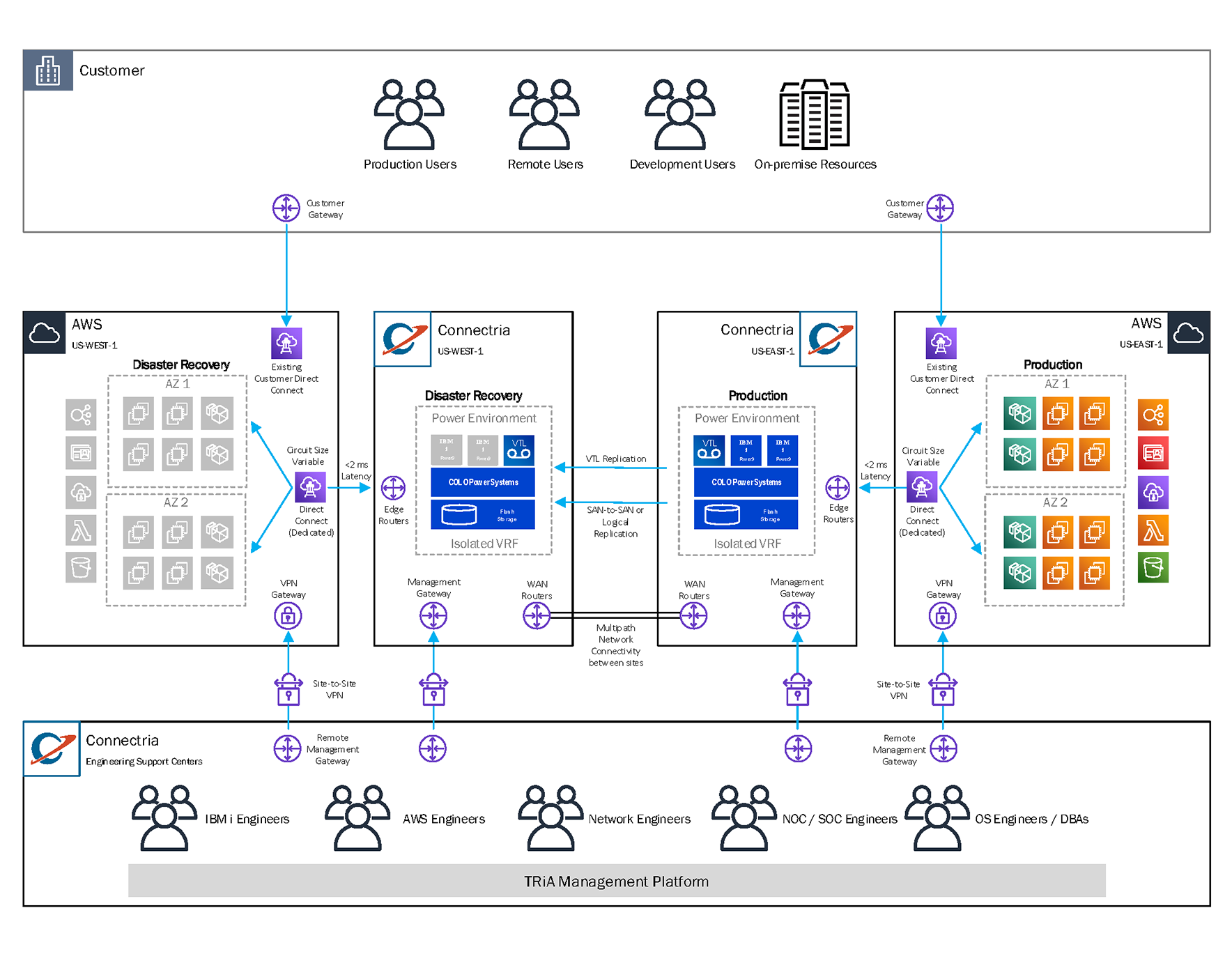
This example shows a production/DR environment with no connections into Connectria’s data center. Here, the customer is shown using their existing direct connect into AWS and co-locating their Power Systems boxes in our data center.
Let’s say, for instance, you already had a US East/US West environment and existing direct connects into the environment. But then you decide you don’t want to go through the process of standing up any kind of circuit. For the initial onboarding process, Connectria could have a site-to-site VPN tunnel and then remove it upon project completion and do your MIMIX. Then once you get to your cutover, you continue with this direct connect and eliminate any other connectivity into Connectria’s data center except for traffic that would be passing from the Amazon environment as it stands going back into our environment.
Here, instead of a dedicated or cloud IBM Power series box, if you wanted to bring your own or leased system into our data center, you could. When it comes to larger systems, such as a P30 Class type equipment (with a several million-dollar investment), IBM allows for two methodologies for customers to transfer existing IBM i entitlements:
- The customer buys new hardware.
- The customer leases hardware.
Those are the only options available to enable you to transfer any existing IBM i entitlements from one system to another. In either case, we can’t own the hardware. We can provide the data center space, management, power cooling, rack space, etc. We just cannot provide the specific hardware.
5. Production Only
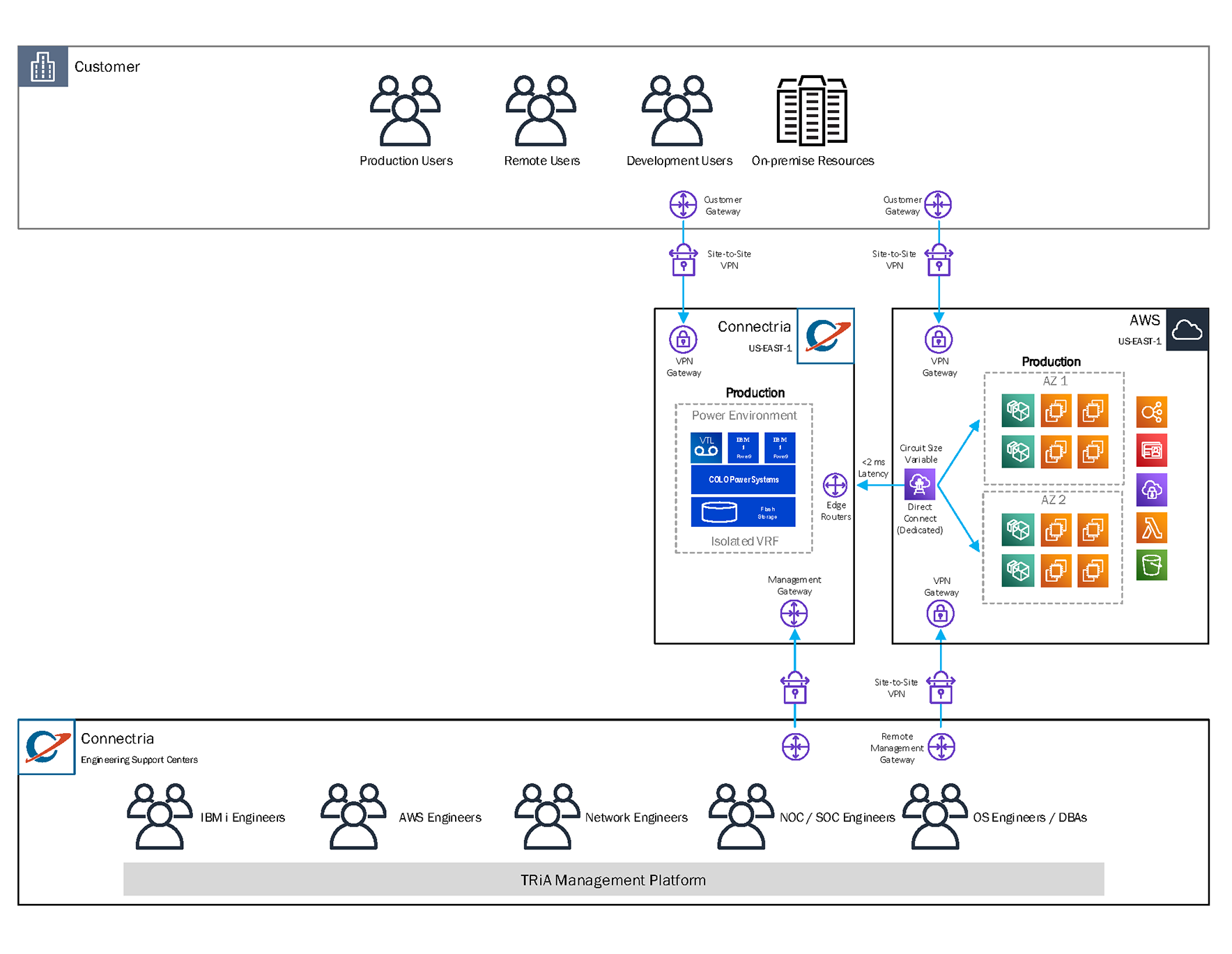
This is a production-only environment using a co-located Power Systems box. This environment is intended to illustrate what is possible if you are just interested in production and uninterested in DR altogether. Here, I show site-to-site VPN, but any of the previously described connectivity methods would be possible.
From Infrastructure to Innovation
In the past, not all customers were able to take advantage of AWS services because of complications from the diversity of their on-premises environments, most being mission-critical in nature. We want to ensure all of our customers have the opportunity to take full advantage of AWS services.
As a leading AWS Consulting Partner & Audited Managed Service provider, our comprehensive suite of AWS services has helped hundreds of organizations successfully move to the cloud, continually optimize their AWS environments, and free up IT resources to focus on more strategic initiatives. By combining our IBM and AWS capabilities, Connectria is able to deliver the first end-to-end solution of this kind, starting with the migration of your existing IBM i/AIX environment, as-is, to our modern IBM Power Systems environment — with full 24/7 managed services — and backed by our next-generation cloud management platform, TRiA.
Speak with one of our experts today. Ultimately, we aim to take the complexity out of managing IBM and AWS by helping you migrate and manage your environments, so your team can focus on innovation instead of infrastructure. We can support you in the way you are most comfortable whether that is in your data center, in our data center, or in a data center in close proximity to AWS. Whichever way you slice it, we can support you.
Keep Reading
Prepare for the future
Tell us about your current environment and we’ll show you the best path forward.
Fast track your project. Give us a call.


